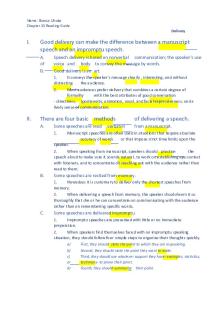Chapter 5.1 Reading Guide PDF

| Title | Chapter 5.1 Reading Guide |
|---|---|
| Author | Logan Brophy |
| Course | Foundations of Biology I (3,3) |
| Institution | James Madison University |
| Pages | 2 |
| File Size | 93.9 KB |
| File Type | |
| Total Downloads | 13 |
| Total Views | 156 |
Summary
Professor Rife, received an A...
Description
Chapter 5 Reading Guide: Organizing Principles: Lipids, Membranes, and Cell Compartments The targeted reading is created to guide your study, directing your attention to the content that will help you meet the learning objectives. There are detailed Learning Objectives at the end of the document if you need extra guidance. The answers to the Self-Assessment Questions are also included.
5.1 Structure of Cell Membranes (p.93-98) Cell membranes are composed of lipids, proteins and carbohydrates LO 5.1 Describe the components of cell membranes. Terminology: Cell theory: Amphipathic: having both hydrophilic and hydrophobic regions Micelles: a spherical structure in which lipids with bulky heads and a single hydrophobic tail are packed Bilayer: a two-layered structure of the cell membrane with hydrophilic “heads” pointing outward toward the aqueous environment and hydrophobic “tails” oriented inward away from water Liposomes: an enclosed bilayer structure spontaneously formed by phospholipids in environments with neutral pH, like water Fluid: when describing membranes, the ability of membrane lipids to move in the plane of the membrane Cholesterol: an amphipathic lipid that is a major component of animal cell membranes Lipid rafts: lipid assembled in a defined patch in the cell membrane Transporters: membrane proteins that move ions or other molecules across the cell membrane Receptors: a molecule on cell membranes that detects critical features of the environment. Receptors detecting signals that easily cross the cell membrane are sometimes found in the cytoplasm Enzymes: a protein that functions as a catalyst to accelerate the rate of a chemical reaction; enzymes are critical in determining which chemical reactions take place in a cell Anchors: a membrane protein that attaches to other proteins and helps to maintain cell structure and shape Integral membrane proteins: a protein that is permanently associated with the cell membrane and cannot be separated from the membrane experimentally without destroying the membrane itself Peripheral membrane proteins: a protein that is temporarily associated with the lipid bilayer or with integral membrane proteins through weak noncovalent interactions Transmembrane proteins: proteins that span the entire lipid bilayer; most integral membrane proteins are transmembrane proteins Fluid mosaic model: a model that proposes that the lipid bilayer is a fluid structure that allows molecules to move laterally within the membrane and is a mosaic of two types of molecules, lipids, and proteins Self-Assessment Questions: 1. Reminder which of the following things are associated with having more fluidity in a membrane? A. Saturated Fats or Unsaturated Fats (circle one) B. Long Fatty Acids or Short Fatty Acids (circle one) 2. The interior region of a phospholipid bilayer is characterized as: A. B. C. D.
hydrophobic
hydrophilic. polar. hydrophilic and polar.
3. Which part of a cholesterol molecule is polar? A. B. C. D.
the hydrocarbon tail
the four interconnected planar rings the OH group both the four interconnected planar rings and the hydrocarbon tail...
Similar Free PDFs

Chapter 5 Reading Guide
- 9 Pages

Chapter 8 Reading Guide
- 7 Pages

Chapter 15 Reading Guide
- 3 Pages

Chapter 15 Reading Guide
- 2 Pages

Chapter 5.1 Reading Guide
- 2 Pages

Chapter 11 Reading Guide
- 2 Pages

Chapter 14 Reading Guide
- 2 Pages

Chapter 13 Reading Guide
- 4 Pages

Chapter 1 Reading Guide
- 3 Pages

Chapter 7 Reading guide
- 9 Pages

Chapter 6 Reading Guide
- 3 Pages

Chapter 11 Reading Guide
- 12 Pages

Chapter 18 Reading Guide
- 4 Pages

Metcalf Chapter 2 Reading Guide
- 2 Pages

Amsco chapter 6 reading guide
- 12 Pages

Chapter 1 Active Reading Guide
- 4 Pages
Popular Institutions
- Tinajero National High School - Annex
- Politeknik Caltex Riau
- Yokohama City University
- SGT University
- University of Al-Qadisiyah
- Divine Word College of Vigan
- Techniek College Rotterdam
- Universidade de Santiago
- Universiti Teknologi MARA Cawangan Johor Kampus Pasir Gudang
- Poltekkes Kemenkes Yogyakarta
- Baguio City National High School
- Colegio san marcos
- preparatoria uno
- Centro de Bachillerato Tecnológico Industrial y de Servicios No. 107
- Dalian Maritime University
- Quang Trung Secondary School
- Colegio Tecnológico en Informática
- Corporación Regional de Educación Superior
- Grupo CEDVA
- Dar Al Uloom University
- Centro de Estudios Preuniversitarios de la Universidad Nacional de Ingeniería
- 上智大学
- Aakash International School, Nuna Majara
- San Felipe Neri Catholic School
- Kang Chiao International School - New Taipei City
- Misamis Occidental National High School
- Institución Educativa Escuela Normal Juan Ladrilleros
- Kolehiyo ng Pantukan
- Batanes State College
- Instituto Continental
- Sekolah Menengah Kejuruan Kesehatan Kaltara (Tarakan)
- Colegio de La Inmaculada Concepcion - Cebu